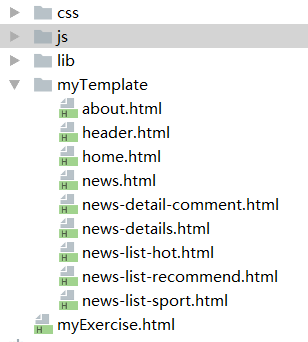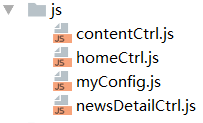最近研究了一下ui-view多层嵌套,整理了一下
1.最简单的ui-view用法
html部分:
<ul class="nav navbar-nav"> <li ui-sref-active="active"><a ui-sref="home">首页</a></li> <li ui-sref-active="active"><a ui-sref="news">新闻</a></li> <li ui-sref-active="active"><a ui-sref="center">个人中心</a></li> </ul> <div class="wrap" ui-view></div>
路由配置:
var app = angular.module('myApp',["ui.router"]); app.config(["$stateProvider","$urlRouterProvider", function ($stateProvider,$urlRouterProvider) { $stateProvider .state("home", { url: '/home', templateUrl:'template/home.html', controller:'homeCtrl' }) .state("news", { url: '/news', templateUrl:'template/news.html', controller:'newsCtrl' }) .state("details",{ url:'/news/details', templateUrl:'template/newsDetails.html', controller:'detailsCtrl' }) .state("center", { url: '/center', templateUrl:'template/setCenter.html', controller:'centerCtrl' }); $urlRouterProvider.otherwise('/home'); }]);
2.多视口
html部分:
<ul class="nav navbar-nav"> <li ui-sref-active="active"><a ui-sref="home">首页</a></li> <li ui-sref-active="active"><a ui-sref="home.news">新闻</a></li> <li ui-sref-active="active"><a ui-sref="home.center">个人中心</a></li> </ul> <div class="warp"> <div class="main" ui-view="home"></div> <div class="left" ui-view="left"></div> <div class="right" ui-view="right"></div> </div>
路由配置:
var app = angular.module('myApp',["ui.router","ui.bootstrap"]); app.config(["$stateProvider","$urlRouterProvider", function ($stateProvider,$urlRouterProvider) { $stateProvider .state("home", { url: '/home', views:{ 'home':{template:"<div class='body' ui-view='body'></div><div class='footer' ui-view='footer'></div>"}, 'left':{template:"<span>left</span>"}, 'right':{template:"<span>right</span>"}, 'body@home':{templateUrl:'template_views/home.html'}, 'footer@home':{template:"<span>首页底部</span>"} } }) .state('home.news',{ url:'/news', views:{ 'body@home':{templateUrl:'template_views/news.html'}, 'footer@home':{template:"<span>新闻底部</span>"} } }) .state('home.newsDetails',{ url:"/news/details/:id", views:{ 'body@home':{ template:"<span>新闻详情</span>", controller:function ($stateParams) { alert('id:'+ $stateParams.id); } }, 'footer@home':{template:"<span>新闻详情底部</span>"} } }) .state('home.center',{ url:'/center', views:{ 'body@home':{templateUrl:'template_views/setCenter.html'}, 'footer@home':{template:"<span>个人中心底部</span>"} } }); $urlRouterProvider.otherwise('/home'); }]);
这里需要注意的是路由传参,这里把news.html内容贴出来
<uib-tabset active="activeJustified" justified="true"> <uib-tab index="0" heading="推荐"> <div style=" 100%;height: 500px;background-color:pink;"> <span class="mouseHand btn" ui-sref="home.newsDetails({id:1})">Justified content</span> </div> </uib-tab> <uib-tab index="1" heading="热点"> <div style=" 100%;height: 500px;background-color:#b9def0;" ui-sref="home.newsDetails({id:2})">Short Labeled Justified content</div> </uib-tab> <uib-tab index="2" heading="股票"> <div style=" 100%;height: 500px;background-color:darkcyan;" ui-sref="home.newsDetails({id:3})">Long Labeled Justified content</div> </uib-tab> </uib-tabset>
ui-sref="home.newsDetails({id:1})"这样跳转的时候就把id传给了新闻详情;在新闻详情的控制器里就可以通过$stateParams.id得到传过来的id
3.多层ui-view嵌套
写了一个小demo,首先看一下结构

myExercise.html代码:
<!DOCTYPE html> <html lang="en" ng-app="myApp"> <head> <meta charset="UTF-8"> <script src="lib/angular.js"></script> <script src="lib/angular-ui-router.js"></script> <script src="lib/jquery-1.12.3.js"></script> <script src="lib/bootstrap.js"></script> <script src="lib/ocLazyLoad-master/dist/ocLazyLoad.js"></script> <script src="js/myConfig.js"></script> <script src="js/contentCtrl.js"></script> <link rel="stylesheet" href="lib/bootstrap.css"> <link rel="stylesheet" href="css/base.css"> <title>ui-view三层嵌套</title> </head> <body> <div ui-view class="wrap"></div> </body> </html>
ocLazyLoad.js是用来分步加载js,css等文件的,后面可以再路由配置里看到具体用法,有了这个对于项目初次加载的速度有很大提升,但是不需要的这里也可以不必引入;
js文件夹结构

前两个控制器都是空的,没写什么逻辑就不展示了,先看一下myConfig.js,路由配置(多层嵌套精髓都在这里啦):
var app = angular.module('myApp',["ui.router","oc.lazyLoad"]); app.config(function ($stateProvider,$locationProvider, $urlRouterProvider,$ocLazyLoadProvider) { $stateProvider .state('content',{ url: '/', views:{ "":{ template: '<div ui-view="header"></div><div ui-view="body"></div>', controller:'contentCtrl' }, "header@content":{templateUrl: 'myTemplate/header.html'} } }) .state('content.home',{ url:'home', views:{ "body@content":{ templateUrl:'myTemplate/home.html', controller:'homeCtrl' } }, resolve:{ deps: ['$ocLazyLoad', function($ocLazyLoad) { // you can lazy load files for an existing module return $ocLazyLoad.load([ 'js/homeCtrl.js', 'css/home.css' ]); }] } }) .state('content.news',{ url:'news', views:{ "body@content":{template:'<div ui-view></div>'} } }) .state('content.news.list',{ url:'/list', templateUrl:'myTemplate/news.html' }) .state('content.news.list.recommend',{ url:'/recommend', templateUrl:'myTemplate/news-list-recommend.html' }) .state('content.news.list.hot',{ url:'/hot', templateUrl:'myTemplate/news-list-hot.html' }) .state('content.news.list.sport',{ url:'/sport', templateUrl:'myTemplate/news-list-sport.html' }) .state('content.news.details',{ url:'/details/:type/:id', templateUrl:'myTemplate/news-details.html', controller:'newsDetailCtrl', resolve:{ deps: ['$ocLazyLoad', function($ocLazyLoad) { // you can lazy load files for an existing module return $ocLazyLoad.load([ 'js/newsDetailCtrl.js', 'css/newsDetail.css' ]); }] } }) .state('content.news.details.comment',{ url:'/details/comment', templateUrl:'myTemplate/news-detail-comment.html' }) .state('content.about',{ url:'about', views:{ "body@content":{templateUrl:'myTemplate/about.html'} } }); $urlRouterProvider.otherwise('home'); });
结合路由配置,看一下template模板代码:
首先是header.html
<ul class="nav nav-tabs"> <li role="presentation" class="active" ui-sref-active="active"><a ui-sref="content.home">Home</a></li> <li role="presentation" ui-sref-active="active"><a ui-sref="content.news.list.recommend">News</a></li> <li role="presentation" ui-sref-active="active"><a ui-sref="content.about">About</a></li> </ul>
news.html
<ul class="nav nav-tabs"> <li role="presentation" class="active" ui-sref-active="active"><a ui-sref="content.news.list.recommend">推荐</a></li> <li role="presentation" ui-sref-active="active"><a ui-sref="content.news.list.hot">热门</a></li> <li role="presentation" ui-sref-active="active"><a ui-sref="content.news.list.sport">体育</a></li> </ul> <div ui-view></div>
news-details.html
<span>{{type}}:新闻详情</span> <a ui-sref=".comment">查看评论</a> <div ui-view></div>
<!--news-list-recommend.html--> <div> 推荐列表 <a ui-sref="^.^.details({type:'recommend',id:2})">点击查看新闻详情,通过相对路径跳转</a> </div> <!--news-list-hot.html--> <div> 热门列表 <a ui-sref="content.news.details({type:'hot',id:5})">点击查看新闻详情,通过绝对路径跳转</a> </div> <!--news-list-sport.html--> <div> 体育列表 <a ui-sref="content.news.details({type:'sport',id:7})">点击查看新闻详情</a> </div>
模板就展示这几个了,其它的都是随便写的text文字了,随便写点东西就行,到这里就差不多完成了.
接下来展示一下newsDeatilCtrl.js
angular.module('myApp').controller('newsDetailCtrl',['$scope','$stateParams',function ($scope,$stateParams) {
$scope.type = $stateParams.type;
}]);
这里通过$stateParams来接收路由跳转传过来的参数。
好啦,到这里就大功告成了。